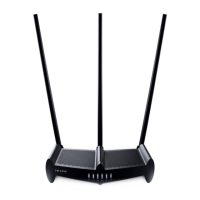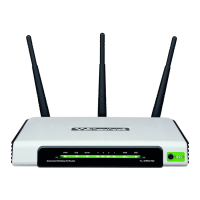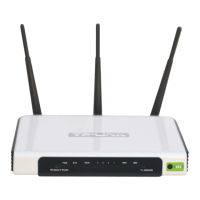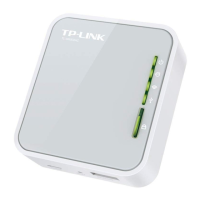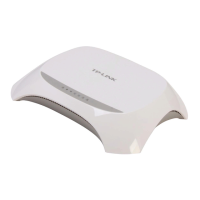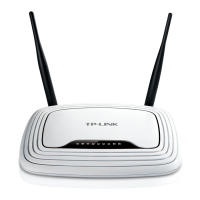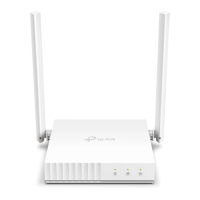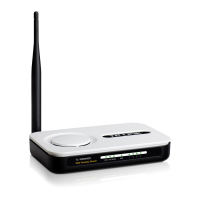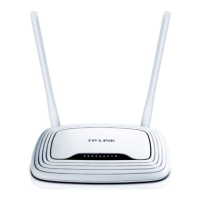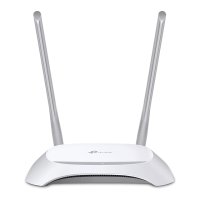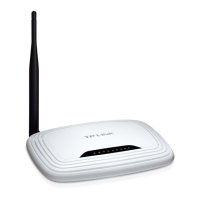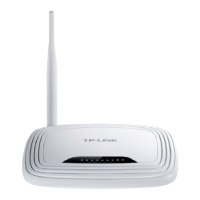Do you have a question about the TP-Link TL-WR941N and is the answer not in the manual?
Describes the router's integrated functions, speed, security, and ease of use.
Explains the terminology used in the guide for TL-WR941N/TL-WR941ND.
Details the LEDs and QSS button located on the front of the router.
Describes the ports and buttons on the rear panel of the router.
Lists the necessary hardware and software for connecting the router.
Specifies optimal placement and environmental conditions for the router.
Provides step-by-step instructions for physically connecting the router to the network.
Explains how to configure PC IP settings for router communication.
Guides users through the router's web-based setup wizard.
Describes how to access the router's web-based utility.
Explains how to view the router's current operational status information.
Refers to the Quick Installation Guide for initial configuration.
Guides on adding wireless devices using the Quick Secure Setup feature.
Introduces network configuration options including LAN, WAN, and MAC Clone.
Details how to configure the router's Local Area Network (LAN) settings.
Explains configuration for Wide Area Network (WAN) connection types like Dynamic IP/Static IP.
Describes how to clone a MAC address, often required by ISPs.
Introduces wireless network settings like SSID, region, channel, and security.
Configures basic wireless parameters like SSID, region, channel, and mode.
Covers WEP, WPA, WPA2, and PSK security modes for wireless networks.
Allows control of wireless access based on MAC addresses.
Configures advanced wireless parameters like transmit power and beacon interval.
Displays statistics for connected wireless stations, including packets sent/received.
Manages the Dynamic Host Configuration Protocol server settings.
Configures the DHCP server's IP address range, lease time, and gateway.
Shows a list of devices currently connected and assigned IP addresses.
Allows static IP assignment for specific devices on the LAN.
Manages port forwarding, DMZ, and UPnP for network services.
Sets up port forwarding for specific applications and services.
Configures dynamic port forwarding based on outgoing traffic.
Exposes a specific host on the LAN to the internet for special services.
Manages Universal Plug and Play for automatic device discovery and configuration.
Covers firewall, VPN passthrough, and ALG settings for network protection.
Configures SPI firewall, VPN passthrough, and Application Layer Gateway (ALG).
Provides DoS protection and packet filtering options.
Controls access to the router's web interface using MAC addresses.
Configures remote access to the router's web interface.
Allows setting internet access restrictions and schedules for specific PCs.
Manages rules for controlling internet access based on host, target, and schedule.
Defines specific internet access control rules (allow/deny).
Manages lists of hosts (IP or MAC addresses) for access control rules.
Defines target destinations (IP, domain) for access control rules.
Creates time schedules for access control rules.
Configures static routes for directing network traffic.
Manages upload and download bandwidth limits for network traffic.
Sets overall bandwidth control and line type.
Defines specific bandwidth control rules for IP ranges or ports.
Links IP addresses to MAC addresses to prevent unauthorized network access.
Configures ARP binding between IP and MAC addresses.
Displays the ARP cache, showing IP-to-MAC address relationships.
Configures dynamic DNS services to access the network with a fixed domain name.
Setup instructions for Comexe.cn Dynamic DNS service.
Setup instructions for Dyndns.org Dynamic DNS service.
Setup instructions for No-ip.com Dynamic DNS service.
Provides tools for time settings, diagnostics, firmware upgrades, and logging.
Configures the router's date, time, and time zone.
Offers Ping and Traceroute tools to test network connectivity.
Guides on updating the router's firmware to the latest version.
Explains how to restore the router's settings to factory defaults.
Allows saving and restoring router configuration settings.
Explains how to restart the router for settings to take effect.
Guides on changing the router's default login username and password.
Details how to view system logs for troubleshooting and monitoring.
Displays network traffic statistics, including packet and byte counts.
Covers standards, protocols, ports, LEDs, and safety certifications.
Details wireless band, data rate, security, and antenna specifications.
Lists operating and storage conditions for temperature and humidity.
Describes the router's integrated functions, speed, security, and ease of use.
Explains the terminology used in the guide for TL-WR941N/TL-WR941ND.
Details the LEDs and QSS button located on the front of the router.
Describes the ports and buttons on the rear panel of the router.
Lists the necessary hardware and software for connecting the router.
Specifies optimal placement and environmental conditions for the router.
Provides step-by-step instructions for physically connecting the router to the network.
Explains how to configure PC IP settings for router communication.
Guides users through the router's web-based setup wizard.
Describes how to access the router's web-based utility.
Explains how to view the router's current operational status information.
Refers to the Quick Installation Guide for initial configuration.
Guides on adding wireless devices using the Quick Secure Setup feature.
Introduces network configuration options including LAN, WAN, and MAC Clone.
Details how to configure the router's Local Area Network (LAN) settings.
Explains configuration for Wide Area Network (WAN) connection types like Dynamic IP/Static IP.
Describes how to clone a MAC address, often required by ISPs.
Introduces wireless network settings like SSID, region, channel, and security.
Configures basic wireless parameters like SSID, region, channel, and mode.
Covers WEP, WPA, WPA2, and PSK security modes for wireless networks.
Allows control of wireless access based on MAC addresses.
Configures advanced wireless parameters like transmit power and beacon interval.
Displays statistics for connected wireless stations, including packets sent/received.
Manages the Dynamic Host Configuration Protocol server settings.
Configures the DHCP server's IP address range, lease time, and gateway.
Shows a list of devices currently connected and assigned IP addresses.
Allows static IP assignment for specific devices on the LAN.
Manages port forwarding, DMZ, and UPnP for network services.
Sets up port forwarding for specific applications and services.
Configures dynamic port forwarding based on outgoing traffic.
Exposes a specific host on the LAN to the internet for special services.
Manages Universal Plug and Play for automatic device discovery and configuration.
Covers firewall, VPN passthrough, and ALG settings for network protection.
Configures SPI firewall, VPN passthrough, and Application Layer Gateway (ALG).
Provides DoS protection and packet filtering options.
Controls access to the router's web interface using MAC addresses.
Configures remote access to the router's web interface.
Allows setting internet access restrictions and schedules for specific PCs.
Manages rules for controlling internet access based on host, target, and schedule.
Defines specific internet access control rules (allow/deny).
Manages lists of hosts (IP or MAC addresses) for access control rules.
Defines target destinations (IP, domain) for access control rules.
Creates time schedules for access control rules.
Configures static routes for directing network traffic.
Manages upload and download bandwidth limits for network traffic.
Sets overall bandwidth control and line type.
Defines specific bandwidth control rules for IP ranges or ports.
Links IP addresses to MAC addresses to prevent unauthorized network access.
Configures ARP binding between IP and MAC addresses.
Displays the ARP cache, showing IP-to-MAC address relationships.
Configures dynamic DNS services to access the network with a fixed domain name.
Setup instructions for Comexe.cn Dynamic DNS service.
Setup instructions for Dyndns.org Dynamic DNS service.
Setup instructions for No-ip.com Dynamic DNS service.
Provides tools for time settings, diagnostics, firmware upgrades, and logging.
Configures the router's date, time, and time zone.
Offers Ping and Traceroute tools to test network connectivity.
Guides on updating the router's firmware to the latest version.
Explains how to restore the router's settings to factory defaults.
Allows saving and restoring router configuration settings.
Explains how to restart the router for settings to take effect.
Guides on changing the router's default login username and password.
Details how to view system logs for troubleshooting and monitoring.
Displays network traffic statistics, including packet and byte counts.
Covers standards, protocols, ports, LEDs, and safety certifications.
Details wireless band, data rate, security, and antenna specifications.
Lists operating and storage conditions for temperature and humidity.
| Brand | TP-Link |
|---|---|
| Model | TL-WR941N |
| Category | Wireless Router |
| Language | English |
